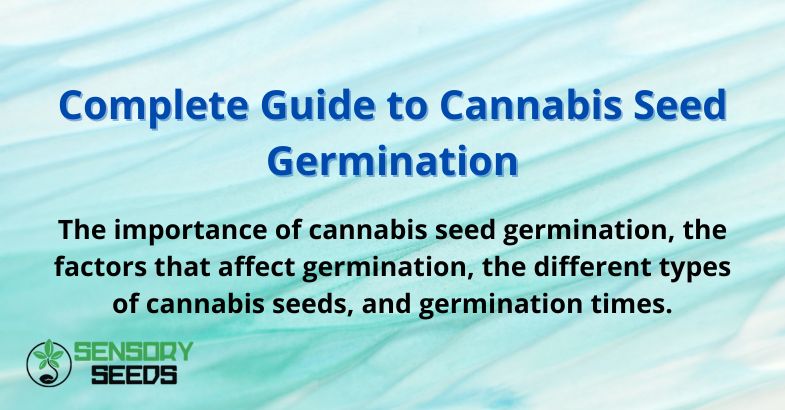Published on: 23/05/2025
The importance of cannabis seed germination, the factors that affect germination, the different types of cannabis seeds, and germination times.
Germinating cannabis seeds is the first essential step to obtaining healthy and productive plants. Knowing how to properly start this process ensures a high success rate in cultivation, preventing waste and optimizing plant growth.
Whether the seeds are autoflowering, feminized, or fast-growing, they must be handled carefully and placed in optimal conditions to ensure the best development. In this guide, we will cover all aspects of germination, from key factors to expected timing, and the most effective methods for germinating cannabis seeds.
Key Factors for Cannabis Seed Germination
To achieve successful germination, several crucial factors must be considered. These directly influence the success of the process and the well-being of the plants. Every aspect must be carefully monitored to ensure a good start to the growth process.
- Humidity: Water is essential to trigger the germination process. Cannabis seeds absorb water to activate their metabolic functions, but it is crucial to maintain balanced humidity. Too much water can cause the seed to rot or mold, while insufficient humidity can slow down or completely stop germination. It is important to keep the substrate moist but not soaked, ensuring that the environment does not become too humid, especially if the seed is placed in a container or on a paper towel.
- Temperature: Temperature plays a crucial role in germination. Cannabis seeds thrive when the temperature is between 20°C and 25°C. In this range, chemical and biological reactions inside the seed occur most efficiently. Temperatures that are too low, below 18°C, can slow down or halt the process, while temperatures that are too high, above 30°C, can damage the seed and compromise germination. A hot environment can rapidly dehydrate the seeds, preventing proper activation. Temperature control is particularly important when growing in enclosed environments such as greenhouses or indoor rooms.
- Light: During the germination phase, cannabis seeds should be kept in the dark or in low light. Light is not required for the actual germination process and can even damage the seeds if exposed too early. Light becomes essential only when the sprout emerges from the seed, signaling that the germination phase is over and the seedling is ready to start the photosynthesis process. For this reason, it is advisable to keep seeds in a dark environment, such as under a paper towel or in an opaque container, until germination is complete.
- Substrate Quality: The substrate in which the seeds are placed must be sterile and well-aerated to facilitate proper germination. A good substrate not only needs to retain moisture but also allow oxygen to pass through to the roots during growth. Too compact or dense substrates can suffocate the weed seeds and prevent root development. It is important to use light soils, such as peat or a well-aerated soil mix, that offer the right balance of moisture and oxygenation. Additionally, the substrate should be free of pathogens or other contaminants that could damage the seed or emerging seedling.
- Delicate Handling: Seeds are particularly fragile. Handling them with too much force or dropping them can compromise their germination potential. When the sprout begins to emerge, it must be treated with the utmost care. It is important to avoid damaging the delicate stem or emerging root, which are crucial for the initial growth of the plant. Furthermore, the seed itself should not be crushed or damaged during transfer to the substrate. Careful handling greatly increases the chances of a healthy and vigorous plant start.
In summary, successful germination depends on the optimal combination of humidity, temperature, light, substrate quality, and careful handling. Each factor must be carefully regulated to promote healthy seed development and ensure robust and productive plants.
Read also: What Is Wax? How Is It Made?
Cannabis Seed Germination Times
The germination of cannabis seeds can vary depending on the strain, seed freshness, and environmental conditions. Typically, fresh and cannabis high-quality seeds begin to sprout within 24-72 hours, but sometimes they may take up to 7 days. Autoflowering cannabis seeds tend to germinate more quickly compared to feminized varieties due to their genetics, which promote a fast growth cycle. On the other hand, feminized seeds take longer, especially in environments with less-than-ideal conditions.
If no signs of germination appear after a week, it’s important to check the humidity, temperature, and seed quality. The ideal temperature for germination is between 20 and 25 degrees Celsius, while humidity should be moderate—neither too high nor too low. Low temperatures or excessive humidity can slow down or hinder the germination process.
Finally, the seed quality is crucial. Fresh and well-preserved seeds germinate faster and with greater success. If the seed is old or poorly stored, it may not germinate at all. In general, it’s important to carefully monitor all environmental factors to ensure optimal germination.


Methods of Cannabis Seed Germination
There are several methods to germinate cannabis seeds, each with its unique characteristics and advantages. The choice of method depends on personal preferences, available equipment, and environmental conditions. Below are some of the most common methods, along with an overview of their benefits and drawbacks.
-
Paper Towel Method
The paper towel method is one of the simplest and most popular methods. Marijuana Seeds are placed between two layers of moist paper towels and kept in a warm, dark place until the root emerges. This method is particularly appreciated for its ease of execution and low cost. Additionally, it allows for easy monitoring of the process since the root can be seen through the paper.
However, despite being a simple method, it has some disadvantages. For example, if the paper towel is not kept sufficiently moist or if the seeds are not transferred to the substrate at the right time, the germination may not occur properly. In some cases, the seed may get damaged, especially if the root grows too long within the paper or if the paper dries out before the seed fully germinates. Additionally, the risk of damaging the plant increases if the grower does not manage humidity correctly.
-
Water Glass Method
The water glass method is another popular technique, where seeds are immersed in room-temperature water for 12-24 hours. After this period, the seeds are transferred to an appropriate substrate to complete the germination process. A significant advantage of this method is that the water helps soften the seed shell, stimulating germination and potentially improving the success rate, especially with older or harder seeds.
However, there are risks associated with this method. If the seeds are left too long in the water, they may drown, compromising germination. Also, not all seeds respond well to stagnant water, and some may not germinate or develop properly. Another factor to consider is that if the water is not changed regularly, conditions could become favorable for the growth of bacteria or fungi, which could damage the seeds.
-
Direct Soil Germination
Direct soil germination is one of the most natural methods, where seeds are planted directly into a moist, well-aerated substrate. This method is ideal for those who prefer a process that mimics the plant’s natural cycle without needing to manipulate the seed too much. Additionally, there are no issues with transplanting, as the feminized seeds are already in their final growing medium.
A significant advantage of this method is that the seed is placed directly in its final environment, which reduces the risk of damaging the root during transplantation. However, an important disadvantage is that it is not easy to monitor the germination process since the seed is hidden in the soil. Also, if the substrate is not sufficiently moist or well-aerated, the germination may not proceed correctly. In addition, if the soil is too dense or compact, the plant may have difficulty emerging.
-
Use of Peat Discs or Rock Wool
The use of peat discs or rock wool is another widely used method. These substrates retain moisture and create a favorable environment for seed germination, and the seeds can later be transplanted without damaging the roots. A major advantage of this method is the ease of transplantation: since the plants are already contained in a medium that allows the roots to grow freely, transplanting is much easier, and the roots are less likely to suffer damage.
However, one of the disadvantages is that purchasing peat discs or rock wool can be expensive, especially if a large number of seeds are being cultivated. Additionally, these materials are not always environmentally friendly, as peat comes from bogs, which raises concerns about sustainability. Even though peat discs or rock wool retain moisture well, it is essential to regularly monitor the humidity levels. If the discs dry out too quickly, the seeds may not germinate properly.
Types of Cannabis Seeds
There are several categories of cannabis seeds, each with specific characteristics:
-
Autoflowering Cannabis Seeds
Autoflower cannabis seeds are one of the most popular options among growers, especially beginners, due to their ability to automatically flower without relying on light cycles. Unlike photoperiod strains, which require a change in the number of light hours to enter the flowering phase, autoflowering strains begin to flower naturally after a few weeks of germination. This characteristic makes them ideal for those seeking a quick harvest without the complexities of light management.They are also known for their resistance to adverse climatic conditions, pests, and diseases, making them perfect for growers in regions with shorter growing seasons.
Autoflowering seeds offer several advantages during the germination phase. Once planted, they tend to germinate quickly, allowing the seedlings to develop rapidly and reducing the overall life cycle time. Furthermore, their ability to flower automatically eliminates the need to modify the light cycle, making them particularly suitable for those with little experience in cultivation. Thanks to their resilience, they can germinate even in less-than-ideal environmental conditions, providing a higher likelihood of success for less experienced growers.
However, there are also some disadvantages to consider. Due to their short life cycle, any mistakes during germination or the early growth stages can irreparably affect the harvest. Additionally, because of their accelerated development, these plants tend to stay smaller compared to photoperiod varieties, limiting the amount of buds they produce. This can be a drawback for those looking for larger yields.


-
Feminized Cannabis Seeds
Feminized cannabis seeds are specifically developed to ensure that every plant grown is female, meaning it will produce flowers rich in cannabinoids like THC and CBD. With this type of seed, the risk of getting male plants, which could pollinate female plants and compromise the harvest, is eliminated. This allows growers to focus solely on the growth and care of female plants without the need to select and remove male plants. Feminized cannabis seeds are particularly valued for their ability to maximize yield and the quality of the harvest, both in indoor and outdoor cultivation.
During germination, feminized seeds have a very high success rate, especially when purchased from reputable suppliers. Thanks to their genetic uniformity, they tend to grow more consistently and vigorously compared to regular seeds. Another strong point is the guarantee of production: all plants will be female, eliminating the risk of discarding male plants and optimizing space and resources.
Despite the advantages, this type of seed requires more attention during germination. Some varieties may be more sensitive to temperature and humidity fluctuations, requiring careful environmental control to avoid stress that could compromise seedling development. Additionally, feminized seeds are generally more expensive than other types because the genetic selection process to eliminate male plants increases production costs.
-
Fast Flowering Cannabis Seeds
Fast flowering cannabis seeds are an excellent option for those who want to harvest in shorter time frames compared to traditional varieties. These seeds result from a cross between feminized and autoflowering genetics, which significantly reduces the flowering period without sacrificing the quality of the buds. Thanks to this trait, growers can achieve more harvests per year or harvest before unfavorable climatic conditions arrive. This variety is particularly useful for outdoor cultivation, where the available time to mature plants may be limited.One of the main advantages of fast flowering seeds is their ability to germinate quickly and develop rapidly, reducing the overall cultivation time compared to traditional photoperiod strains. Additionally, since they are a cross between feminized and autoflowering seeds, they inherit greater resilience, making them more robust and adaptable to varying cultivation conditions. Another benefit is the possibility of obtaining multiple harvests within a year, making them particularly appealing for those looking to maximize production.
Despite the many advantages, fast flowering seeds tend to be more sensitive than autoflowering ones and require optimal environmental conditions for successful germination. This means the grower must pay special attention to factors like humidity, temperature, and substrate quality, as mistakes in these areas could compromise the initial growth of the seedling. Furthermore, unlike autoflowering plants, those from fast flowering seeds still rely on the light cycle to trigger flowering, requiring careful management of lighting, especially in indoor cultivation.
Read also: How to Make a Marijuana Brownie
Conclusion
To start a lush and productive cannabis cultivation, the germination phase is crucial. By applying the right techniques and choosing quality seeds, excellent results can be achieved from the early stages of growth. This guide will provide you with all the necessary information to successfully start the germination process and cultivate strong, healthy plants.
To achieve effective germination, it is essential to start with high-quality cannabis seeds. Relying on certified suppliers like Sensoryseeds is a smart choice, as they offer a wide selection of marijuana seeds, including autoflowering, feminized, and fast-flowering varieties. Purchasing from reliable retailers significantly increases the chances of success in germination and plant development.









